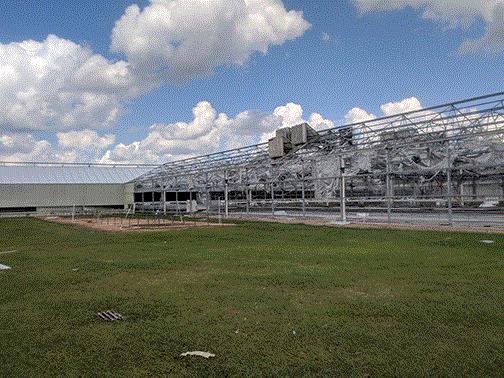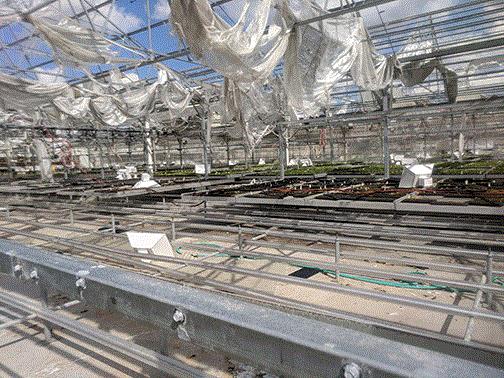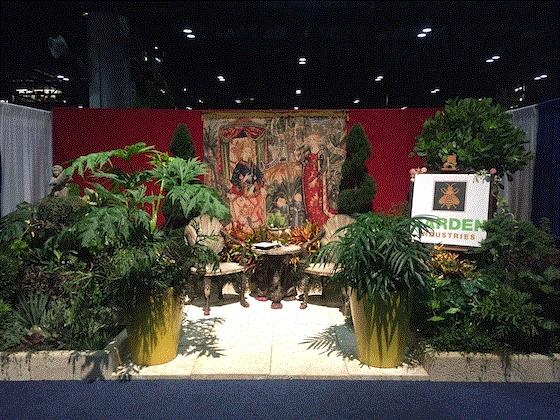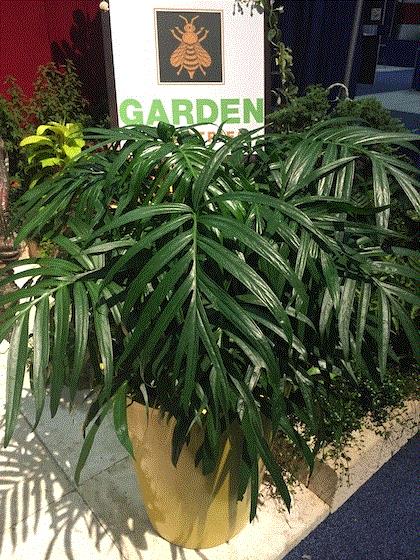Oglesby Rebounding from Michael
Bossman Chris Beytes did it again—he beat me to some important tropicals information. Here's what he reported in this week’s Acres Online concerning Oglesby Plants International and the aftermath of October’s Hurricane Michael.
I was wondering who in our industry was hit hard by Hurricane Michael, the category 4 storm that struck the Florida Panhandle October 10, and I’ve heard from a well-known one: Oglesby Plants International. I had completely forgot that Altha, their home base, is in that neck of the woods, which Google tells me is just 60 miles from Mexico Beach, where the storm made landfall. With power out and communication sparse, they had little way to let folks know how they fared until recently, when they sent out a press release to assure customers they were down, but not out, and that shipping would resume the week of October 29. Said the release:
“We were in the worst of the hurricane’s eye wall and we were hit hard,” said Gary Hennen, president of Oglesby. “Most of our greenhouses were out of commission and one destroyed. Our lab sustained roof and water damage. Out of power until October 24 and still no communications. The damage could have been mistaken for a tornado.”


That’s not surprising to hear, considering that Michael was the fourth-most-powerful hurricane in terms of wind speed (155 mph), to hit the contiguous United States on record and the most powerful to hit the Florida Panhandle. Oglesby says it was the worst damage they’ve experienced in their 70-plus-year history.
Naturally, the industry has stepped up to help, including donations and support from the Florida Nursery, Growers and Landscape Association and “friends all across the industry.”
“We’re so grateful for the help from FNGLA, Higgins AG [who is helping with reconstruction], our friends, and the hard work of our Oglesby team,” said Gary. “It’s been tough, but we’re seeing light at the end of the tunnel and we’ll make it through.”
Though initial availabilities will be limited, they say liner supplies will increase in step with infrastructure repairs in the coming weeks and months.
Best of luck with the cleanup and repairs, Gary. Glad your team is safe and we’re all eager to see you back up and running at 110% soon!

Meanwhile, in Hawaii …
Richard Criley, my “man in the field” in Hawaii, sent me a link to an article in the Hawaii Tribune-Herald that tallies the economic disaster wrought on agriculture by this summer’s volcanic eruptions. “Floriculture alone lost over $13 million just in crops, not counting infrastructure, supplies, grower homes, etc.,” Richard wrote as a manner of introduction to what I was about to read.
According to the Tribune-Herald, a survey conducted by the University of Hawaii’s College of Tropical Agriculture and Human Resources of just 46 Big Island farms reveals that just these respondents alone lost approximately $27.9 million in destroyed property. Not all farmers responded, so the damage can be expected to be much higher.
Photo from the Hawaii Tribune-Herald.
The $13 million loss for floriculture is essentially all orchids. The Kapoho region had ideal growing conditions for orchid growers. The Hawaii Floriculture and Nursery Association president Eric Tanouye estimates that about 10% of the state’s 300 members had been affected by the Kilauea eruption. With much of the current crop lost and the orchid cycle taking at least two years to produce, “It’s a big decision for anyone to choose to go back into debt,” Eric told the newspaper.
Other ag industries were hit hard, too, according to the survey. There is an estimated $6.5 million loss for the papaya industry and $2.5 million for the macadamia nut industry.
My question to you, Hawaii industry members, how can we help? Write in with your thoughts HERE.

Speaking of Orchids …
Westerlay Orchids of Carpinteria, California, announced last month that they will be adding 39 acres in Oxnard to their orchid facilities portfolio. The space where they will build the new state-of-the-art greenhouses is currently in use as open agriculture and is less than two miles from the ocean. Great view, I’m sure, but more importantly the ocean will provide cool temperatures for the proper cultivation of their orchids.
Said Westerlay owner Toine Overgaag in a press release about the expansion, “Long-term sustainability is our driving motivation. Orchids need a specific environment to thrive and building a new state-of-the-art facility in Oxnard will help us continue raising the bar in the orchid market.” And let’s talk about just how state-of-the-art this facility will be: They are aiming for carbon neutral production, 100% recycled water and solar panels. The timeline for build-out is three years.
Westerlay owner Toine Overgaag.
Meanwhile, Westerlay’s 14 acres of greenhouses in Carpinteria are still churning out the orchids. And once the Oxnard facility is up and running, they plan on keeping the 14 acres at their Carpinteria site, too. They are projecting producing as many as 3 million orchids there in Carpinteria next year alone.

Who Are These Guys?
A few weeks back, I received a press release from the folks at Loxahatchee-based Garden Industries proudly announcing that their booth brought home the first place prize for the 10 ft. by 20 ft. category at The Landscape Show, which was held in early October. Their display, the release said, had an Italian courtyard theme with all sorts of luxurious plantings—succulents, aroids, tropicals and such—positioned before a red suede backdrop. Just take a look. Not bad for first-timers at the Landscape Show, I’d say.

Just who is Garden Industries, you ask? I had the same question. The company provides plant material to landscape contractors and wholesale buyers. That’s the short answer. For the longer answer I replied to David Bache, their sales director, to find out.
Here’s the scoop: The Garden Industries nursery was previously Life Force Nursery, which produced big, immediate-gratification plants for hedging and screening purposes. Think palms and Green Island ficus-type items. “Nothing wrong with that, but not very exciting,” David wrote. David, who had been with Boynton Botanicals as their sales director, came to Life Force after the Boynton Botanicals owners retired and closed the nursery at the end of last year. In fact, a bunch of Boynton Botanicals folks came along.
Life Force began a rebranding process in January that included, in addition to a name change, refocusing on their products. “The rebranding was based on the expectation that there would be a gap in the industry for impeccably grown, weed-free, properly fertilized and pruned material,” David explained. “In other words, we declared that we’d build a world-class nursery to serve the needs of the industry.”
Since rebranding, they’ve expanded the nursery by clearing about nine acres of land, built more shade houses, added drip irrigation and expanded their offerings to about 425 varieties.

Garden Industries' Amydrium zippelianum from Papua New Guinea (above) and Philodendron warszewiczii (below). According to David, "These were mercilessly handled during the show."
“We are fortunate in that we have long-standing relationships with clients who bring us cuttings of plants that are not commercially available, and have a large network of suppliers who offer us some unusual items,” David continued. “We’ve been able to use these to propagate many plants that we would otherwise not have access to, some of which would likely be lost to the industry.” Like what? How about a color-changing stachytarpheta or a hybrid bird nest-type anthurium? “We continually trial plants from out of our area (California, mostly) to see how viable they would be for South Florida. Some have been very successful, some not so.”
So, there’s your answer. I’m looking forward to possibly seeing them at TPIE this coming January.
Vista Farms Celebrates 30
The folks at Vista Farms are putting on a bougainvillea bash to celebrate their 30 years in business. While we’ve seen their bougainvillea at Spring Trials for many years, they produce other young plants, too; specifically hibiscus and ixora.
Vista Farms' Fire Opal bougainvillea from the 2015 Spring Trials.
The Juana Diaz, Puerto Rico-based nursery will be opening up their facilities Friday, December 14, and welcome their customers, suppliers and friends to attend. You can even tour the facilities and meet with company management to talk a little business while you’re there.
Puerto Rico in December sounds warm and inviting! If you think so too, RSVP to Nannette Reynes at nannette@vistafarms.com or call 1-787-837-9077.
Comments, questions or news to share? Just drop me a line at ewells@ballpublishing.com.

Ellen Wells
Editor-at-Large
Green Profit
This edition of Tropical Topics was sent to 27,078 loyal readers!
If you're interested in advertising on Tropical Topics, contact Kim Brown ASAP!